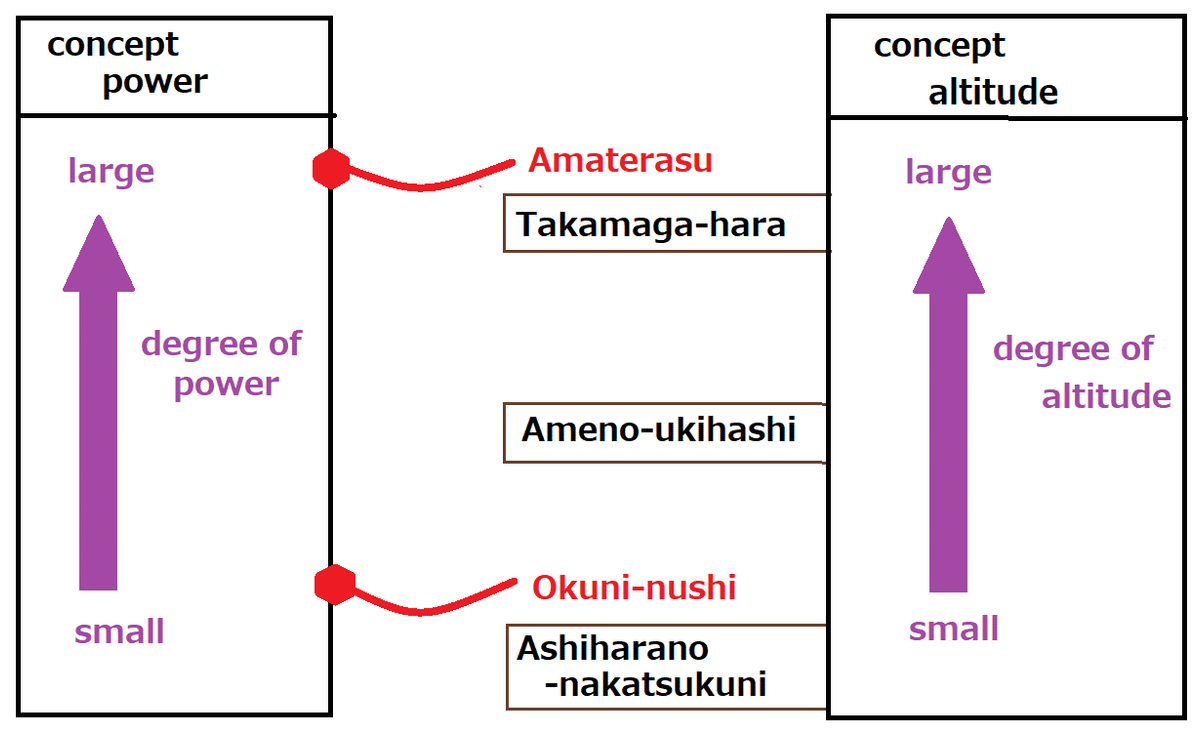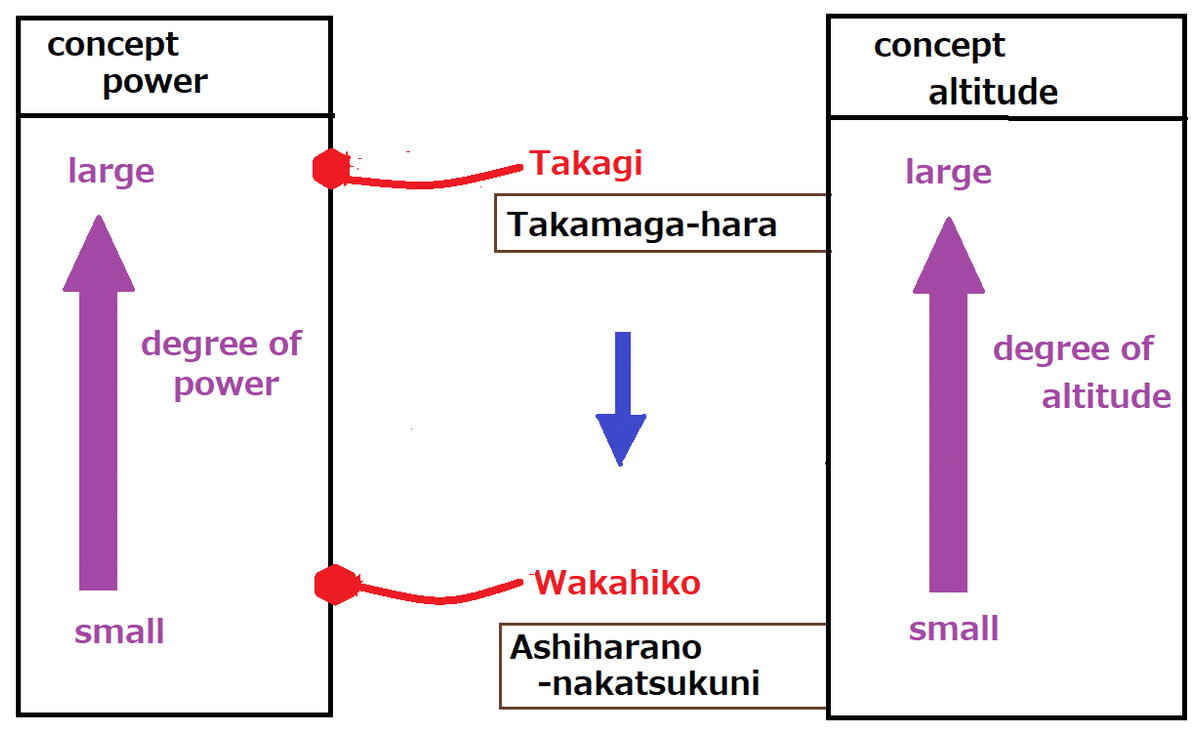Stage of Power and Altitude, 権威と高度の舞台
Language and Expression, Index, 言語と表現, インデックス へ
-----
2024.7.12 presented in [note] ( //note.com/runningWater/]
----------
1 Introduction, はじめに
In ,
において、
it was shown that,
Among the various myths and tales, that exist around the world,
there is ones, that have
a certain (linguistic) composition,
that is,
[a composition in which, [[power] and [altitude]] are related].
世界中に存在する様々な神話や説話の中に、
ある種の(言語上の)構図
を持つもの、
すなわち、
[[[権威]と[高度]] が関係してくるような構図]
を持つものが、
存在する、
ということが、示された。
Furthermore, as examples, the following composition of the myths were presented.
[Tower of Babel], (Migdal Babel)
[Arrow of Nimrôd]
Transfer of [Ashiharano-Nakatsukuni]
更に、その例として、以下の説話の構図が、示された。
[Tower of Babel], (Migdal Babel), [バベルの塔]
[Arrow of Nimrôd]. [ニムロッドの矢]
Transfer of [Ashiharano-Nakatsukuni], [アシハラノナカツクニ]の譲渡
In that presentation, I explained each of these subjects, showing the composition of each of them. In this content, I would like to present a more precise version of that composition.
そこでは、それらの題材について、各々の構図を示しながら、説明したのであったが、このコンテンツにおいては、その構図を更に精密にしたものを示したいと、思う。
As its subject matter,
[Transfer of [Ashiharano-Nakatsukuni]],
to be used.
その題材として、使用するのは、
[Transfer of [Ashiharano-Nakatsukuni]], [[アシハラノナカツクニ]の譲渡]
である。
This myth is found in [Kojiki], a book established in ancient Japan.
この神話は、[古事記]という、古代日本に成立した書籍の中に、あるものだ。
The method of explanation would be as follows,
The synopsis is given in chronological order,
and [the composition of the scene] is shown, at various points.
I hope, you will read this presentation, as if, you were looking at a construction site, where a stage is being set up.
そのあらすじを、時間順に述べながら、
その所々で、[その場面の構図]を示す、
というような方法で、説明を行っていく。
舞台の設営の工事現場を見るような感じで、読んでいっていただければよいかと、思う。
----------
2 Pre-settings, 事前の設定
In [Kojiki], before this transfer ( of [Ashiharano-Nakatsukuni]), the following settings have already been made.
古事記の記述においては、この譲渡([アシハラノナカツクニ]の)に至る前の段階で、以下のような設定が、すでに、なされている。
2.1 Location Setting, 場所の設定
In [Kojiki], the following three [fields] have been set up.
古事記の中では、以下の3つの[場]が、設定されている。
[Takamaga-hara]
[タカマガハラ(高天原)]
[Ameno-ukihashi]
[アメノウキハシ(天の浮橋)]
[Ashiharano-nakatsukuni]
[アシハラノナカツクニ(葦原中国)]
-----
The notation for [Takamaga-hara],
consists of
three [kanji ( Chinese character)], as seen in the figure below (Fig 2.1).
Two of which (the character, that means [high], the character, that means [sky] ) are
reminiscent of "high place".
Therefore, it is suggested that,
this field has a large altitude value.
[タカマガハラ(高天原)](という地名の表記)は、下図(Fig 2.1)に見るような、3個の漢字から成っているのだが、そのうち2個の文字(高、天)は、「高い所」を連想させるようなものである。
ゆえに、
この地は、大きな標高値を持つ場所である
ということを、示唆している。

-----
The notation for [Ashiharano-Nakatukuni],
consists of
four [kanji], as seen in the figure below (Fig 2.2).
The image of a "Phragmites australis field" does not suggest a high altitude place, but on the contrary, a low marshy area.
[アシハラノナカツクニ(葦原中国)]は、下図(Fig 2.2)に見るような、4個の漢字から成っているのだが、「葦が生える原」というイメージからは、そこが、標高の高い所である、というような連想は生じない、逆に、低湿地を連想させる。

-----
[Ameno-ukihashi is assumed, in the [Kojiki], to be located midway (in altitude), between the above two locations.
[アメノウキハシ(天の浮橋)]は、上記2つの場所の中間(標高において)に位置すると、[古事記]では想定されている。
-----
Based on the above points, I decided to set the stage, as follows.
以上の点を踏まえた上で、以下のように、舞台を設定していくことにした。
First, two pillars, erected, that is,
The pillar, corresponding to the [concept [power]]
and
The pillar, corresponding to the [concept [altitude]]
まず、柱を2本、立てる。
[権威]の概念に対応する柱[concept [power]]
と
[高度]の概念に対応する柱[concept [altitude]

Next,
on the stage, composed of these two pillars,
the three [fields], mentioned above
will be set up.
The location of each
should correspond to
the altitude, associated with the name of each [field].
次に、
この2本の柱によって構成される舞台の上に、
先に述べた3個の[場]を、
設置していく。
それぞれを設置する位置は、
それぞれの場の名前から連想される高度
に対応する所に、設定する。

And,
the two main characters in this chapter ( of [Kojiki] )
that is,
[Amaterasu] ( who governs [Takamaga-hara] )
[Okuni-nushi] ( who governs [Ashiharano-nakatsukuni])
will be set up,
to the [field], where each of them governs.
そして、[古事記]のこの章に登場する2ハシラの主役、すなわち、
[Amaterasu] ([Takamaga-hara] を統治している)
[Okuni-nushi] ([Ashiharano-nakatsukuni] を統治している)
を、
それぞれが統治している[場]に、セットする。

Next, ropes are launched horizontally, from the main characters.
次に、主役から、ロープが、水平方向に発射される。

The tip of the rope moves horizontally, and sticks to [concept power (pillar) ]. Its position indicates the amount of [power] ([degree of power]) that, the two characters have.
ロープの先端は、水平方向に移動し、[concept power]の柱に、付着する。その位置が、二人の主役が持っている[権威]の量([degree of power]を示している。

That of [Amaterasu] is larger than, that of [Okuni-nushi]. In other words, [Amaterasu] is superior to [Okuni-nushi], in [power].
[Amaterasu]のそれは、[Okuni-nushi]のそれよりも、大きい。すなわち、[権威(power)]において、[Amaterasu]は、[Okuni-nushi]よりも、優位にあるのだ。
In,
About [orientational metaphor], [方向性のメタファー] について
において、
The following are some of the things considered,
We, human-beings have the habits, such as the following,
associate ( link, relate )
spatial upper/lower (relation)
and
social superiority ( for example, amount of [power] )
以下のようなことを、考察した
我々人類は、次のような習性を持っている、
空間的な上と下(spatial upper/lower)
と
社会的な優位の関係(例えば、権威の量)
とを、結びつける。
To express the above,
I have devised this description, such that,
The tip of the rope moves horizontally, and sticks to [concept power (pillar) ].
上記の事を表現するために、私は、
ロープの先端は、水平方向に移動し、[concept power]の柱に、付着する。
というような、この描写を、考えついたのだ。
----------
3 Now, the curtain has opened, さぁ、幕が開いた
The first voice on stage, is [Amaterasu].
Hereafter, let us proceed, according to the plot, as written in [Kojiki].
ステージ上で、最初に声を発するのは、 [Amaterasu]だ。
以下、古事記に書かれている筋書にそって、進行させていこう。
(1) [Amaterasu] declared that,
"[Ashiharano-Nakatsukuni] is the land, where my son [Ameno-Oshihomimi] should rule."
[アマテラス]は、宣言した、
「[アシハラノナカツクニ(葦原中国)]は、我が息子・[アメノオシホミミ] が統治すべき地である」
At this point, the third character appears on stage, named [Ameno-Oshihomimi]. In Fig. 3.1 below, I wrote the name of him, as [Oshiho].
Since, he also lives in [Takamaga-hara],
the tip of his rope is also fixed at the location,
where the [degree of power] ( on pillar [concept power]) is large,
just like [Amaterasu].
ここで、3人めの登場人物が、舞台上に姿を現す。[アメノオシホミミ]である。下記のFig 3.1 では、[Oshiho]と表記した。
彼も、[Takamaga-hara]に住んでいるので、
彼のロープの先端も、
[Amaterasu]と同様に、
[concept power]柱 上の[[degree of power]が大]の位置
に、固定されている。

(2) So, [Amaterasu] made [Ameno-oshihomimi], to [descend], from [Takamaga-hara], to [Ashiharano-Nakatsukuni].
そこで、[アマテラス]は、[アメノオシホミミ]を、[アシハラノナカツクニ]に向けて、[天降(あまくだ)]した。
(3)[Ameno-Oshihomimi] stood on [Ameno-ukihashi]. He observed the situation in [Ashiharano-Nakatsukuni], and thought,
"That land is very, very ungovernable."
[アメノオシホミミ]は、 [アメノウキハシ(天の浮橋)]の上に立った。彼は、[アシハラノナカツクニ]の状況を観察して、思った、
「あそこは、とても、統治できそうにない。」

I would like you, to check the location of [the tip of the rope] of [Ameno-Oshihomimi].
Even in the phase after the descent to [Ameno-ukihashi], the location ( of the tip) has not changed.
[Moving in the direction of a field with a smaller [altitude]]
does not change
the amount of his [power].
Such situation are expressed, by the location of the tip of the rope, as shown here.
ここで、 [アメノオシホミミ]のロープの先端の位置を、確認してほしい。
[アメノウキハシ]への下降を行った後の段階においても、その位置(ロープ先端の)は、変わっていない。
より小さい[高度]を持つ場の方向に移動しても、彼の[権威]の量は、変化しない。
そのような状況を、このように、ロープの先端の位置で、表現しているのだ。
(4)[Ameno-Oshihomimi] returned to [Takamaga-hara], and reported that, to his mother.
[アメノオシホミミ]は、[タカマガハラ]に帰還し、母に、その旨を報告した。

----------
4 交渉開始, Commencement of Negotiations
(5)So, [Amaterasu] called a meeting, and consulted the members present,
"That land seems to be a terrible place. There are many members, with immense power, who could become adversaries. Someone must go there, to settle the land. Is there anyone, who is qualified?"
そこで、[アマテラス]は、会議を招集し、列席メンバーに対して、諮問した、
「かの地は、敵対勢力になりうる、勢威の強いものどもが、いっぱいおる、とんでもない所であるようじゃ。誰かに、あそこへ行ってもらわねば、ならぬのぉ。かの地を、平定するためにのぉ。誰か、適任の者は、おらぬか?」
(6)So, [Ameno-hohi] was sent to [Ashiharano-Nakatukuni].
と、いうことで、[アメノホヒ]が、[アシハラノナカツクニ]へ、派遣されることになった。
(7)However, [Ameno-hohi] was always trying to curry favor with [Okuni-nushi] ( the ruler of [Ashiharano-Nakatsukuni]), and remained there, and did not report to [Amaterasu] at all.
ところが、[アメノホヒ]は、オオクニヌシのご機嫌取りに終始し、そのまま、そこに居続け、[アマテラス]への報告を、一切してこない。
----------
5 The Appearance of [Ameno-wakahiko], [アメノワカヒコ]登場
(8)So, next, [Ameno-wakahiko] was sent.
そこで、次に、[アメノワカヒコ]が、派遣された。
In this phase, a very unique character appears, [Ameno-wakahiko]. In the following figures, I wrote the name of him, as [Wakahiko].
Since he also lives in [Takamaga-hara], the tip of his rope is also fixed at the position, where the [degree of power] on [concept power] is large, just like [Amaterasu].
この局面において、極めて特異なキャラクターが登場する、[アメノワカヒコ]である。以降の図においては、[Wakahiko]と表記した。
彼も、[Takamaga-hara]に住んでいるので、 彼のロープの先端も、[Amaterasu]と同様に、柱[concept power]の[degree of power]が大の位置に、固定されている。


I would like you, to check the location of [the tip of the rope] of [Ameno-wakahiko].
Even in the phase after the descent to [Ashiharano-Nakatsukuni], the location ( of the tip) has not changed.
[Moving in the direction of a field with a smaller [altitude]]
does not change
the amount of his [power].
Such situation are expressed, by the location of the tip of the rope, as shown here.
ここで、 [アメノワカヒコ]のロープの先端の位置を、確認してほしい。
[アシハラノナカツクニ]への下降を行った後の段階においても、その位置(ロープ先端の)は、変わっていない。
より小さい[高度]を持つ場の方向に移動しても、彼の[権威]の量は、変化しない。
そのような状況を、このように、ロープの先端の位置で、表現しているのだ。
(9)However, [Ameno-wakahiko] went to [Ashiharano-Nakatsukuni], and married [Shitateru-hime] (the daughter of [Okuni-nushi]). With his ambition to become the ruler of [Ashiharano-Nakatsukuni], [Ameno-wakahiko] remained there, never reporting to [Amaterasu].
しかし、[アシハラノナカツクニ]に行った[アメノワカヒコ]は、[シタテルヒメ]([オオクニヌシ]の娘)と結婚し、[アシハラノナカツクニ]の統治者になろう、という野心を抱き、そのまま、そこに居続け、[アマテラス]への報告を、一切してこない。

Note the difference between this figure and Fig 3.5. The location of the tip of the rope of [Ameno-wakahiko] has changed.
As he spent his days at [Ashiharano-Nakatsukuni], his body and mind were transformed into a [one of [Ashiharano-Nakatsukuni] side]. This being the case, the location of the end of the rope had to change as well. In other words, the amount of his [power] was reduced to a level, equal to that of [Okuni-nushi].
この図とFig 3.5との違いに注目してほしい。 [アメノワカヒコ]のロープの先端の位置が、変化している。
[アシハラノナカツクニ]での日々を過ごすうちに、彼は、身も心も、[[アシハラノナカツクニ]サイドの者]に、変わってしまったのである。そうなると、ロープの先端の位置も、変化せざるをえない。すなわち、彼の[権威]の量は、[オオクニヌシ]のそれに等しいようなレベルにまで、縮小してしまった。
That is why, in the next phase of the struggle, against the [Takamaga-hara] forces, he was defeated. The difference in [power] was the deciding factor.
だからこそ、この次の段階において、彼は、[タカマガハラ]勢力との戦いに、敗北してしまうのだ。[権威]の差が、勝敗を決めた、といってよいだろう。
In the process of leaving [Takamaga-hara] and thereafter,
the location of the tip of [Ameno-wakahiko]'s rope (that indicates the amount of his [power])
and
[altitude] of the location, where [Ameno-wakahiko]'s body is located.
,
plotted in a two-dimensional coordinate space, the figure below
(Fig 3.7, Fig 3.8) is obtained.
[タカマガハラ]を出てから以降の過程における、
[アメノワカヒコ]のロープの先端の位置(それは、[彼の[権威]の量]を示す)
と
[アメノワカヒコ]の身体がある場所の[高度]
を、
2次元座標空間の中に、プロットすると、下図(Fig 3.7, Fig 3.8)のようになる。


This is, so to speak,
[orbital diagram] in the space of [power] and [altitude].
これは、いわば、
[権威]と[高度]の空間中の、軌道図
、とでもいうべきものである。
[(hexagon) mark 1] is the position of the rope tip, at the time, just after departing from [Takamaga-hara].
[mark 2] is the position of the rope tip, at the time, just before entering [Ashiharano-Nakatsukuni].
[mark 3] is the position of the rope tip, at the time, after the becoming established in [Ashiharano-Nakatsukuni].
[(六角形マーク) 1] が、[タカマガハラ]から出発した直後の時点での
[2] が、[アシハラノナカツクニ]に入る直前の時点での
[3] が、[アシハラノナカツクニ]に定着後の時点での
ロープ先端位置である。
If, he gradually developed the [ambition, to be the ruler of [Ashiharano-Nakatsukuni]],
the tip of the rope would follow the orbit, shown in Fig. 3.7,
and if he had already begun to have ambitions, before entering [Ashiharano-Nakatsukuni],
the tip of the rope would follow the orbit, shown in Fig. 3.8
( [power] of him would drop precipitously).
[[アシハラノナカツクニ]の統治者になろう、という野心]を、彼が徐々に持つようになっていった、というのであれば、ロープ先端は、Fig 3.7 のような軌道を描くだろうし、
[[アシハラノナカツクニ]に入る前にすでに、野心を持ち始めた、というのならば、Fig 3.8 のように(その権威は、急激に低下)なるだろう。
----------
6 [Arrow of Ameno-wakahiko], [アメノワカヒコの矢]
At this phase, one more character is added, in [Takamaga-hara], named [Takagi].
この段階において、[タカマガハラ]には、更に一柱のキャラクターが。その名は、[タカギ]。

(10)The next character sent out by [Takamaga-hara] was a messenger, named [Nakime]. it was a bird, belonging to the [genus Phasianus].
[タカマガハラ]が次に送り出したのは、メッセンジャー、その名は、[ナキメ]、キジの種類に属する鳥であったという。
[Nakime] stood on a tree, in front of the gate of [Ameno-wakahiko]'s house, and delivered the message as directed by [Takamaga-hara],
[ナキメ]は、アメノワカヒコの家の門の前にある木の上に立ち、[タカマガハラ]で指示された通りに、メッセージを伝えた、
"You have been dispatched with the order to [defeat the adversaries in [Ashiharano-Nakatsukuni], and settle the land]. Yet, for eight years, you have not reported anything to [Takamaga-hara]. What the hell are you doing?"
「[アシハラノナカツクニ]の敵対勢力を破り、そこを平定せよ」との指令のもと、おまえは、派遣されているのだぞ。なのに、8年もの間、おまえから、タカマガハラに対して、何の報告もない。いったい、どういうつもりなのか、おまえは!」
(11)Hearing this, [Ameno-sagume] said to [Ameno-wakahiko],
"That bird call is bad. Why don't you just use your bow?"
それを聞いた、[アメノサグメ]は、[アメノワカヒコ]に、言った。
「あの鳥の鳴き声、悪いです。弓、使ったら、よいのでは?」
[Ameno-wakahiko] shot an arrow at [Nakime]. The arrow penetrated [Nakime]'s body, and reached [Takamaga-hara].
[アメノワカヒコ]は、[ナキメ]めがけて、矢を射た。その矢は、[ナキメ]の身体を貫通し、[タカマガハラ]に達した。

(12)[Takagi] thrust the arrow back, and sent it down.
The arrow hit [Ameno-wakahiko], who was lying on the morning floor, in the chest.
タカギは、その矢を、衝き返し、下した。
その矢は、朝の床に寝ていたアメノワカヒコの胸に、命中した。

(13)To resolve the situation, [Take-mikazuchi] and another members, were sent. As a result of their strong pressure ( to [Okuni-nushi] ), [Okuni-nushi] agreed to hand over [Ashiharano-Nakatsukuni] to [Amaterasu].
事態打開のために、[タケミカヅチ]たちが、派遣された。彼らからの、強圧の結果、[オオクニヌシ]は、[アシハラノナカツクニ]を、[アマテラス]に譲ることに、同意した。
(14)And, [Ninigi] ([Amaterasu]'s grandson) [descend], from [Takamaga-hara], to [Ashiharano-Nakatukuni] (to rule over [Ashiharano-Nakatskuni]).
そして、[ニニギ](アマテラスの孫)が、[アシハラノナカツクニ]へ、([アシハラノナカツクニ]を統治するために)、[天降り(あまくだり)]した。
----------
7 This stage is highly productive, この舞台は生産性が大
Figures, used in the description of [Arrow of Ameno-wakahiko]
(Fig 6.2, Fig 6.3)
can be rewritten, ( rewrite character names, field names)
to create a composition of other stories.
For example, as shown below (Fig 6.4), the composition of [Arrow of Nimrôd] can be made.
[[アメノワカヒコ]の矢]の記述の中で用いられた、図(Fig 6.2, Fig 6.3)から、
書き換えを行う事により(キャラクター名、フィールド名を、変える)
他の物語の構図を生み出せる
例えば、下図 (Fig 6.4)のように、[Arrow of Nimrôd]. [ニムロッドの矢]の説話の構図を作ることができる。

I hope that,
this [Framework of Power and Altitude stage],
presented in this content,
can be used, for the interpretation and creation of various myths and tales.
このコンテンツに述べた、
フレイムワーク : 権威と高度の舞台
は、様々な神話や物語の解釈、創作のために、活用できるのでは、と、私は期待する。
